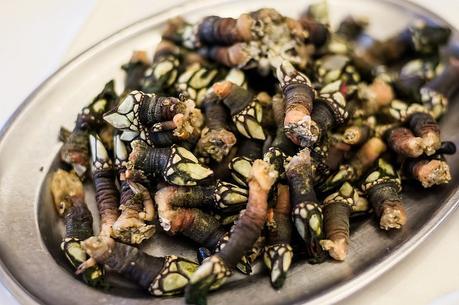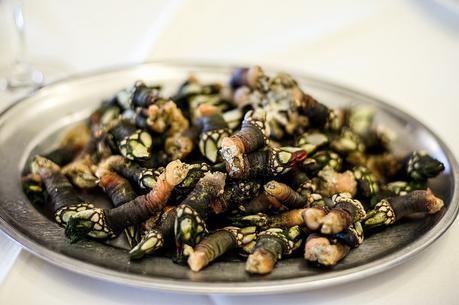
Percebes, aka goose/gooseneck barnacles, are far from appetizing at first sight, even under a hungry gaze. There’s no delicate way to eat them — my father-in-law was covered in a spray of brine, trying to open the first one. Their redeeming feature must be taste, right? This is something you’ll have to find out yourself, if you can figure out how to eat them without getting brined.
Before I forget: this is how you eat them without getting brined. Of course, I had to learn the hard way because I only read the article afterwards.
This plate of barnacles was already sitting on the table by the time we sat down at the restaurant for my mother-in-law’s birthday (yes, Mother-in-Law Restaurante was actually closed for lunch!). A few of us were partaking simply because it was there. After my father-in-law led the way and got a shirtful of saltwater to show for it, I was determined to be more strategic.
It took a few attempts, but I ended up eating them according to the article. That’s luck, plus something I’ve learned about trying new seafood, like limpets in Madeira: I don’t expect to like it at first taste, so I try a bit, eat something else for a while, and then return for Round 2. I find that instead of bombarding my tongue with the flavour, which can backfire, I have to ease in.
As you can see by the picture, percebes resemble bird legs attached to prehistoric mammal toes. (In the kitchen of a high-end Vancouver seafood restaurant, they refer to the fleshy edible bits as “little dog penises”… seriously!) I don’t know how anyone got the bright idea to eat them, but I’d love to know how the first Portuguese person arrived at the name percebes for goose barnacles… was it a pun? Or a bad joke?
“Percebes?” = “Understand?” or “Percebes” = “You understand”
In trying to understand the appeal of this elusive crustacean, I really had to just go for it. But actually, I’d never seen anyone eat it — either on video or in person. I’ve photographed them, but always just before they’ve been sent back to the kitchen. I’ve only met one person who’s professed love for it: a cousin of Paulo’s in Lisbon. She may have inherited that from her father who’s a percebes aficionado, monitoring the season and choosing his suppliers carefully. If you want to eat percebes on a regular basis, you have to learn how to percebes properly, I suppose. They’re an expensive taste.
There aren’t many places in the world where these barnacles are harvested or eaten: Spain, Portugal, Morocco, and Canada. This is probably for the best, since the conditions for harvesting them are perilous. Percebes thrive on rocks that get pummelled by waves, and the bigger the waves the bigger they get. The two methods of retrieval are to free-dive in strong currents (many people have died this way), or wait until low tide and work fast.
This VICE interview with Jody Lot, a percebes fisherman in the Algarve, describes the inherent risks in retrieving these barnacles from the sea.
In Canada, they’re found in Clayoquot Sound, off the west coast of Vancouver Island and only the Nuu-chah-nulth First Nations are licensed to harvest them, as of 2013.
Here’s the rub: you can’t farm these barnacles, nor can you freeze them. They are fickle beasts which need to be caught intact and alive, or they will lose flavor and/or harden.
So you have to ask yourself — is it worth it? Everywhere I’ve read about percebes describes the experience as the closest thing to eating the sea. I’ve seen them compared to lobster, clams, mussels, and more, but the flavor and texture differs to them all. I think it also depends on the quality of barnacle, how fresh it is, and how it’s served. The Iberians like to cook and eat it as they enjoy most of their food — as simple and unadorned as possible — while the North Americans like to blanche or steam them, then add other flavours like wine and herbs. However you eat them, you should probably have some sparkling wine on the side to balance out the flavour, especially after the first try. Although we didn’t order any this time, I’m guessing vinho verde would be a good accompaniment.
For what it’s worth, I didn’t grow up with seafood at all due to my parents’ religion and therefore it became an acquired taste through adulthood. I wasn’t sure I would like percebes, but I wanted to see what could justify risking life and limb for its harvest. I might not percebes this percebes business overnight, but maybe someday.
My tasting method above (trying, leaving, returning) let my tastebuds warm up to the flavor of “eating the sea”. I have to say, I wasn’t at all convinced with the first one. Getting past the bird leg-like outer texture was unappealing and the meat was less than satisfying. But after leaving it for a while then trying again, with each percebe I became more efficient at getting to the meat, which helped to enjoy it more. My initial reaction at the outer texture passed… even without wine.
But here’s my tip: order the wine, anyway.

June 24, 2017
Album: Portugal [Summer 2017]
For more posts/photos of Portuguese food and drink:
https://gailatlarge.com/blog/tag/portuguese-kitchen
https://www.pinterest.com/gailatlarge/portuguese-food-drink/
https://www.instagram.com/gailatlarge/

